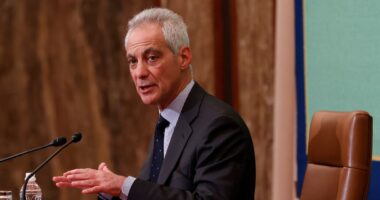
SAN JOSE, Calif.—A jury of eight men and four women were instructed on Friday to begin deliberating the fate of Elizabeth Holmes, the Theranos Inc. founder whose alleged fraud has underpinned one of the biggest white-collar criminal cases in Silicon Valley history.
The jurors are tasked, after hearing from 32 witnesses over three months, with weighing whether Ms. Holmes is guilty of nine charges of wire fraud and two charges of conspiracy to commit wire fraud. Each charge carries a maximum sentence of 20 years.
U.S. District Judge Edward Davila sent jurors out of the courtroom to start deliberations late Friday following jury instructions and a final word from each side. They finished for the day not long after and will return Monday morning.
An attorney for Ms. Holmes had his last opportunity Friday to distance her from the allegations she faces, telling the jury that an accounting error could explain allegations that she inflated revenue projections, and her statements about working with the military were aspirational.
“She believed she was building a technology that would change the world. That’s our story,” defense lawyer Kevin Downey told the jury.
A government prosecutor followed with a final rebuttal, arguing that Theranos was afflicted by “a lack of honesty” that came from its leadership.
Ms. Holmes founded Theranos after dropping out of Stanford University during her sophomore year. She built it up over nearly a dozen years before a series of Wall Street Journal articles beginning in 2015 revealed problems with the company’s vaunted finger-stick blood-testing technology, precipitating regulatory action, criminal charges and Theranos’s eventual collapse in 2018.
Mr. Downey argued that lofty financial projections Theranos gave to investors were grounded in reality. Projections for revenue of about $140 million in 2014 and about $990 million in 2015 accounted for deferred revenue that, had it materialized, would have made those projections accurate, he said. He said he didn’t know why the company thought it could count deferred revenue as actual revenue.
“Investors understood projections were uncertain,” Mr. Downey said.
Ms. Holmes’s lawyer left unaddressed the abuse allegations she lodged against Ramesh “Sunny” Balwani, her former boyfriend and top deputy at Theranos. From the stand, Ms. Holmes said Mr. Balwani was emotionally and sexually abusive, claims his lawyer has strongly denied.
SHARE YOUR THOUGHTS
What have you found most interesting about the Theranos trial? Join the conversation below.
Mr. Downey didn’t attempt to tie the allegations to the case or tell jurors how to contextualize the claims.
Prosecutors addressed the abuse allegations head-on in their closing arguments. Assistant U.S. Attorney John Bostic told the jurors he understood if they felt sympathy for Ms. Holmes, but that the defense didn’t offer any evidence and Ms. Holmes didn’t give any testimony to connect her claims against Mr. Balwani to the fraud charges against her.
“That will leave you wondering why Ms. Holmes testified about those allegations when she was on the stand,” Mr. Bostic said. “You should put it out of your mind.”
When Judge Davila issued an order last year to separate Ms. Holmes’s and Mr. Balwani’s trials, he wrote that Ms. Holmes would “eventually have to connect the alleged abuse to the charged conduct for the abuse to be relevant and admissible.”
Mr. Downey, Ms. Holmes’s lawyer, focused on Ms. Holmes’s interactions with the investors and patients named in the indictment.
“People lost money. I don’t mince words about that,” Mr. Downey told jurors. That potential outcome, however, was known to investors from the start, he said, showing jurors a stock-purchase agreement investors signed saying it was speculative in nature.
Mr. Downey told jurors that Ms. Holmes hadn’t misled investors about work Theranos was doing with the U.S. military. Revisiting a call Ms. Holmes held for investors in 2013, Mr. Downey went sentence by sentence to argue that Ms. Holmes was talking about the potential application of Theranos’s technology in military helicopters or to save soldiers’ lives, not something that was already happening.
“She did not say these devices are in flight for clinical use,” he said.
Contracting records show Theranos’s work with the military was limited in its scope. In total, Theranos appeared to have received less than $9,000 from its military contracts, according to the procurement records. In one case, military officials briefly explored a relationship with Theranos before rejecting the company’s regulatory strategy, the Journal has reported.
Theranos’s investors, Mr. Downey argued, bore some responsibility for their financial losses, saying some of the company’s backers failed to ask questions or educate themselves with publicly known information.
Alan Eisenman, an investor from Texas who sank about $1.2 million into Theranos, testified that he was cheated and lied to by Ms. Holmes. Mr. Downey countered that many of the things that Mr. Eisenman said had been hidden from him were publicly known, including that Theranos performed the traditional needle-in-the arm blood draws as part of its testing services.
Investors who asked questions, such as government witness Chris Lucas, received accurate information from Ms. Holmes, Mr. Downey said.
Mr. Lucas’s testimony didn’t support that assertion. He testified that there was such a disconcerting information deficit from Ms. Holmes that he cautioned his colleagues at Black Diamond Ventures. They made the investment anyway.
“The level of due diligence doesn’t matter,” Mr. Bostic told the jury in his rebuttal. “A scheme to defraud is still a scheme to defraud even if it would only ensnare someone who is less careful than they should be.”
Defense attorney Mr. Downey concluded his arguments by returning to a comment he made in his opening statements: that Ms. Holmes couldn’t have intended to defraud anyone because she never sold a single share in the company, of which she owned about half.
“She believed in this technology,” Mr. Downey said. “She stayed the whole time, and she went down with that ship when it went down.”
Write to Heather Somerville at [email protected], Sara Randazzo at [email protected] and Christopher Weaver at [email protected]
Copyright ©2021 Dow Jones & Company, Inc. All Rights Reserved. 87990cbe856818d5eddac44c7b1cdeb8









